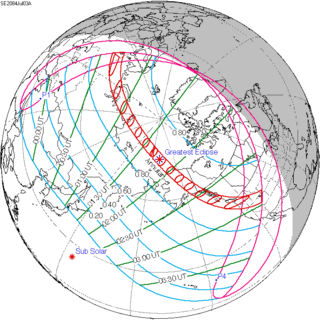| Solar eclipse of July 3, 2084 | |
|---|---|
| Type of eclipse | |
| Nature | Annular |
| Gamma | 0.8208 |
| Magnitude | 0.9421 |
| Maximum eclipse | |
| Duration | 265 s (4 min 25 s) |
| Coordinates | 75°00′N 169°06′W / 75°N 169.1°W |
| Max. width of band | 377 km (234 mi) |
| Times (UTC) | |
| Greatest eclipse | 1:50:26 |
| References | |
| Saros | 128 (62 of 73) |
| Catalog # (SE5000) | 9697 |
An annular solar eclipse will occur at the Moon's descending node of orbit between Sunday, July 2 and Monday, July 3, 2084,[1] with a magnitude of 0.9421. A solar eclipse occurs when the Moon passes between Earth and the Sun, thereby totally or partly obscuring the image of the Sun for a viewer on Earth. An annular solar eclipse occurs when the Moon's apparent diameter is smaller than the Sun's, blocking most of the Sun's light and causing the Sun to look like an annulus (ring). An annular eclipse appears as a partial eclipse over a region of the Earth thousands of kilometres wide. Occurring only about 10 minutes after apogee (on July 3, 2084, at 1:40 UTC), the Moon's apparent diameter will be smaller.[2] Thus, apogee did occur slightly before the peak of this eclipse.
The path of annularity will be visible from parts of Russia (in European Russia north-east of Moscow, passing through Yaroslavl, Vologda and Syktyvkar), Alaska, western Canada, Washington, Oregon, Idaho, northeastern California, Nevada, Utah, and Wyoming. A partial solar eclipse will also be visible for parts of Scandinavia, East Asia, Russia, Hawaii, and western North America.
- ^ "July 2–3, 2084 Annular Solar Eclipse". timeanddate. Retrieved 23 August 2024.
- ^ "Moon Distances for London, United Kingdom, England". timeanddate. Retrieved 23 August 2024.
